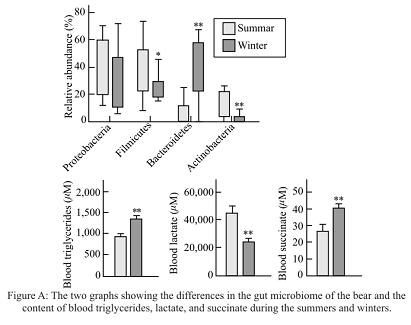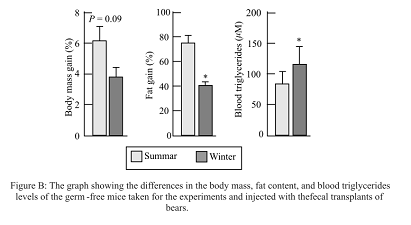
Concept explainers
To review:
The changes in blood triglycerides, lactate, and succinate levels due to seasonal variations in relation to the changes in bears
Given:
Researchers took brown bears (Ursus arctos) for the study of gut microbiota in food digestion and in many other aspects of nutrition. Brown bears undergo hibernation in the drastic winters. Researchers study whether microbiome of the bear’s gut was different or not, before and after the fasting. For this, the blood along with the fecal sample from 16 free-ranging brown bears has taken during hibernation (February or March) and following hibernation (June) for further study. The fecal samples were analyzed for the presence of different microbe communities, while the blood was tested for triglycerides and other nutrients.
The graphs given below were plotted by the researchers after observing the conditions. Graph1 shows the presence of different composition of microbiome during different seasons. Also, the differences in the blood levels of triglycerides, lactate, and succinate are depicted.
The researchers also examined the effects of these microbiota when introduced into germ-free mice. Germ-free mice, unlike normal mice are devoid of gut microbiota and are unable to gain mass when they are kept on a high-fat diet. Fecal transplants from summer or winter bears were given to the germ-free mice. Graph 2 shows the changes in body mass, fat content, and blood triglyceride levels of the mice after 2 weeks.

Graph 1: The two graphs showing the differences in the gut microbiome of the bear and the content of blood triglycerides, lactate, and succinate during the summers and winters.

Graph 2: The graph showing the differences in the body mass, fat content, and blood triglycerides level of the germ-free mice taken for the experiments and injected with the fecal transplants of bears.
Introduction:
Hibernation may be defined as the behavior of animals in unfavorable winters where they becomes inactive and sleeps for a particular interval of time. The animals do not eat during hibernation, thus, they use the stored fat to meet the energy requirements. Before the onset of hibernation, the animals keep on eating to increase their stored fat content.
Explanation of Solution
It was observed that the levels of blood triglycerides in bears were present in a higher amount in winters than summers. The bears undergo hibernation in winters and during hibernation, energy required by the body is obtained by the lipolysis (breakdown or oxidation of lipids) of the stored fat. Also, the lactate content in the body of bears was observed to be in lesser amounts during winters than in summers and the succinate (for gluconeogenesis) content of the body was higher in the winters.
The given data indicates that bears use mobilization and oxidation of lipids along with reduced glucose utilization and increased gluconeogenesis (generation of new glucose) as a survival strategy during hibernation. These strategies help the bears to cope up with the harsh winter environments.
Thus, it is concluded from the data that in bears, the blood triglycerides and succinate content were present in a higher amount in winters during hibernation as compared to summers while the lactate content was present in lower amounts in the winters. The difference in the content of all three components in summers and winters help the bears to cope up with harsh winters.
Want to see more full solutions like this?
Chapter 50 Solutions
Life: The Science of Biology
- Discuss why 200kg Pacific halibut and 200kg Dall’s porpoise differ in their mass-specific metabolic rates.arrow_forwardWhich of the following statements are TRUE?Multiple answers are accepted for this question a .Two molecules of CO2 are produced each time a molecule of Acetyl-CoA is oxidized. b. During the first turn of the TCA Cycle the carbon atoms of Acetyl-CoA become CO2. c. The number of molecules of ATP that can be produced in the Citric Acid Cycle by substrate level phosphorylation of ADP from two molecules of Acetyl-CoA is 30. d. Fumarate contains a trans double bond. The cis isomer of Fumarate is Maleate which cannot serve as carbon source for a cell. e. Lack of O2 would decrease the rate of the Citric Acid Cycle in red blood cells. f. If a potent inhibitor of Succinyl-CoA Synthetaseis is applied to liver cells both energy production and synthesis of carbohydrate would be affected. g. The overall chemical changes that occur during one complete turn of the Citric Acid Cycle is the complete oxidation of one molecule of Acetyl-CoA plus the production of two molecules of CO2 plus the…arrow_forwardThe transformation of glucose to lactate in myocytes releases only about 7% of the free energy released when glucose is completely oxidized to CO2 and H2O. Does this mean that anaerobic glycolysis in muscle is a wasteful use of glucose? Explain.arrow_forward
- Which of the following statements is true? In general, the metabolic oxidation of protein in mammals is less efficient, in terms of energy conserved, than the metabolic oxidation of carbohydrate or fat. Given that the nitrogen of glutamate can be redistributed by transamination, glutamate should be a good supplement for nutritionally poor proteins. Both A and B Neither A nor B Which of the following leads to an increase in blood glucose levels? Activation of insulin-receptor substrates (IRSs) Phosphorylation of glycogen synthase kinase 3 (GSK3) Increased levels of PIP3D. Activation of protein kinase B (PKB) All of the above None of the abovearrow_forwardIn the first step of the TCA cycle the acetyl group of acetyl-CoA is transferred to oxaloacetate to produce citrate. Where will the carbonyl carbon of that acetyl group be after the first CO2 is expelled? Group of answer choices The first carbon of α-ketoglutarate The last carbon of α-ketoglutarate The fourth carbon of α-ketoglutarate The third carbon of α-ketoglutaratearrow_forwardBased on this graph, what does the sudden increase or decrease in ATP, NADH, oxygen and carbon dioxide concentrations mean? How are related these to specific steps in glycolysis and TCA cycle??arrow_forward
- In order to break the carbon-carbon bond of Acetyl-CoA in a way that does not harm the cell, citrate is produced in the TCA cycle. Explain how switching between 6-carbon, 5-carbon and 4-carbon metabolites eventually allows the two carbons of Acetyl-CoA to be converted to CO2 in a way that does not harm the cell.arrow_forwardWhy are leptin injections less helpful for most overweight people than for mice with the obese gene?arrow_forwardIf there was India Ink added to a culture of Paramecium caudatum, it would increase the average number of food vacuoles because India ink contains no sugar or nutrients and the formation of food vacuoles would be the first stage in the metabolic process when digesting nutrient-rich particles. What would be the observed effects on the number of food vacuoles of different concentrations such as 1% (v/v), 10% (v/v), and 25% (v/v) of India ink? Will it change over a duration of 30 minutes?arrow_forward
- What is the yield of ATP when each of the following substrates is completely oxidized to CO2 by a mammalian cellhomogenate? Assume that glycolysis, the citric acid cycle and oxidative phosphorylation are fully active. a) fructose-1,6-bisphosphate b) dihydroxyacetone phosphatearrow_forwardTaking into consideration glycolysis, the pyruvate dehydrogenase complex and the citric acid cycle, how many NAD+ molecules are reduced from a single molecule of dihydroxyacetone phosphate? 4 NAD+ are reduced 5 NAD+ are reduced 8 NAD+ are reduced 10 NAD+ are reduced None of the above answers are correctarrow_forwardIf oxidation of acetyl-CoA yields 10 ATPs per mole through the citric acid cycle, how many ATPs will be derived from the complete metabolic oxidation of 1 mole of alanine in a mammal? Would the corresponding energy yield in a fish be higher or lower? Why? How much energy would be derived from the metabolic oxidation of 1 mole of isoleucine to CO2, H2O, and NH3? Of tyrosine?arrow_forward
 Human Anatomy & Physiology (11th Edition)BiologyISBN:9780134580999Author:Elaine N. Marieb, Katja N. HoehnPublisher:PEARSON
Human Anatomy & Physiology (11th Edition)BiologyISBN:9780134580999Author:Elaine N. Marieb, Katja N. HoehnPublisher:PEARSON Biology 2eBiologyISBN:9781947172517Author:Matthew Douglas, Jung Choi, Mary Ann ClarkPublisher:OpenStax
Biology 2eBiologyISBN:9781947172517Author:Matthew Douglas, Jung Choi, Mary Ann ClarkPublisher:OpenStax Anatomy & PhysiologyBiologyISBN:9781259398629Author:McKinley, Michael P., O'loughlin, Valerie Dean, Bidle, Theresa StouterPublisher:Mcgraw Hill Education,
Anatomy & PhysiologyBiologyISBN:9781259398629Author:McKinley, Michael P., O'loughlin, Valerie Dean, Bidle, Theresa StouterPublisher:Mcgraw Hill Education, Molecular Biology of the Cell (Sixth Edition)BiologyISBN:9780815344322Author:Bruce Alberts, Alexander D. Johnson, Julian Lewis, David Morgan, Martin Raff, Keith Roberts, Peter WalterPublisher:W. W. Norton & Company
Molecular Biology of the Cell (Sixth Edition)BiologyISBN:9780815344322Author:Bruce Alberts, Alexander D. Johnson, Julian Lewis, David Morgan, Martin Raff, Keith Roberts, Peter WalterPublisher:W. W. Norton & Company Laboratory Manual For Human Anatomy & PhysiologyBiologyISBN:9781260159363Author:Martin, Terry R., Prentice-craver, CynthiaPublisher:McGraw-Hill Publishing Co.
Laboratory Manual For Human Anatomy & PhysiologyBiologyISBN:9781260159363Author:Martin, Terry R., Prentice-craver, CynthiaPublisher:McGraw-Hill Publishing Co. Inquiry Into Life (16th Edition)BiologyISBN:9781260231700Author:Sylvia S. Mader, Michael WindelspechtPublisher:McGraw Hill Education
Inquiry Into Life (16th Edition)BiologyISBN:9781260231700Author:Sylvia S. Mader, Michael WindelspechtPublisher:McGraw Hill Education





